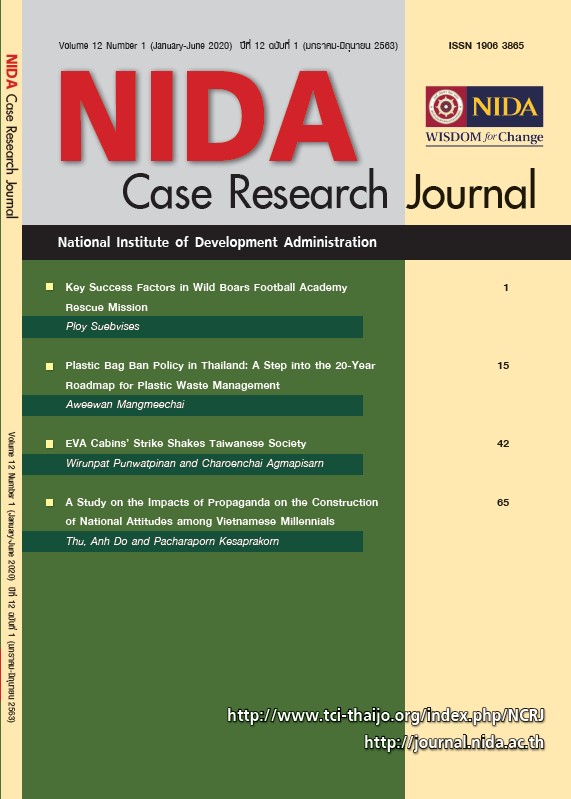A STUDY ON THE IMPACTS OF PROPAGANDA ON THE CONSTRUCTION OF NATIONAL ATTITUDES AMONG VIETNAMESE MILLENNIALS
Keywords:
nation, national attitudes, national identity, propaganda, media exposureAbstract
This study will briefly explore the terms national attitudes in the aspects of national branding and propaganda theory, which brings up a modern and up-to-date perspective of this topic. It also shows the interrelation between Vietnamese millennials’ national attitudes and the impacts of propaganda involved various media. A quantitative survey was conducted in Ho Chi Minh city, Vietnam with the involvement of hundreds seventy-one Vietnamese millennials living in there. It revealed that:
- Vietnamese millennials, having different demographic factors in relations to gender, educational level, income, awareness towards national news, and travel frequency, did not have significant different national attitudes; except for those working in governments, they had significant different national attitudes compared to ones working in the corporates.
- Vietnamese millennials’ media exposure to propaganda, daily exposure to media, and credibility of the media significantly influence their national attitudes. Especially, the credibility of media was the key influence on their perceived national attitudes in the fast changing decade of media.
- The participants perceived their national attitudes were influenced by their exposure to nationalistic propaganda on 5 statements of President Ho Chi Minh and sea security.
In 4.0 era, Vietnamese millennials have more access to various information sources and their media literacy increases. There is a need of open and transparent communication, research and discussion.
References
Anderson, B. (2006). Imagined communities (3rd ed.). UK: Verso.
Andrian, C. (1988). Political change in Vietnam. Political change in the third world, (79), 76 - 118. US and Canada: Routledge.
Anholt, S. (2013). Beyond the nation brand: The role of image and reputation in international relations. The Face of Syracuse University Research. Retrieved January 1, 2017, from https://surface.syr.edu/cgi/viewcontent.cgi?referer=https://www.google.com/&httpsredir=1&article=1013&context=exchange
Berger, A. A. (1995). Essentials of mass communication theory. London: SAGE Publications.
Chen, G. M. (2012). The impact of new media on intercultural communication in global context. China Media Research, 8(2), 1-10. Retrieved Febuary 1, 2018, from http://digitalcommons.uri.edu/cgi/viewcontent.cgi?article=1012&context=com_facpubs
Darr, B. (2011). Nationalism and state legitimation in contemporary China (Thesis Dissertation, University of Iowa). Retrieved January 1, 2017, from http://ir.uiowa.edu/cgi/viewcontent.cgi?article=2771&context=etd.
Dekker, H., Malova, M., & Hoogendorn, S. (2003). Nationalism and its explanations. Paper presented at the first Dutch-Hungarian Conference on Interethnic Relations. Wassenaar: NIAS
DeFleur, M., & Ball-Rokeach, S. J. (1976). A dependency model or mass-media effects. Communication Research, 3(1), 3-21.
Dong, M. H. (2018). Radio broadcasting in 4.0 environment. NLB Online. Retrieved December 1, 2018, from http://nguoilambao.vn/phat-thanh-trong-moi-truong-truyen-thong-40-n9775.html
Driencourt, J.(1950). La Propagande, Nouvelle Force Politique. Pp. viii, 282. Paris: Librairie Armand Colin.
Ellul, J. (1973). Propaganda: The formation of men’s attitudes (Kellen, K., Lerner, J., Trans.). NY, US: Vintage Books Edition (Original work published 1965).
Hoang, T. H. H. (2015). Vietnam cultural policy from the period of renovation (DoiMoi): The preservation of cultural identity in globalization. Retrieved January 1, 2017, from http://rcsd.soc.cmu.ac.th/web/CCSDG/download.php?filename=X%20HOANG%20THI%20HONG%20HA%20CCSDG2015.pdf
Hogg, M., & Vaughan, G. (2005). Social Psychology (4th edition). London: Prentice-Hall.
Kelemen, A. (2000). National sentiments and attitudes towards minorities. Review of Sociology of the Hungarian Sociological Association, 40 - 62. Retrieved January 1, 2017, from http://real-j.mtak.hu/5509/1/SzociologiaiSzemle_2000_spec.pdf
Lasswell, H. D. (1927). Propaganda technique in World War. US: University of Michigan.
Nakayama, T. K., & Martin, J. N. (2010). Intercultural communication in contexts (5th ed.). US, New York: Mc Graw Hill.
Nielson. (2016). The Millennials: Unlock a generation of potential. Retrieved January 1, 2017, from http://www.nielsen.com/content/dam/nielsenglobal/vn/docs/Reports/2016/The%20Millennial%20-%20Unlocking%20a%20generation%20of%20potential.pdf
Media of Vietnam (n.d.). In Wikipedia. Retrieved January 1, 2017, from https://en.wikipedia.org/wiki/Media_of_Vietnam
O’Donnell, V., Jowett, G. S. (2015). Propaganda and persuasion (6th ed.). USA: Sage Publication.
Okwuchukwu, O. D., Ngozi, E., & Emmanuel, U. C. (2014). The media and the challenges of national identity in Nigeria. American Journal of Social Science, 2(3), 49 - 55. Retrieved January 1, 2017, from http://www.openscienceonline.com/journal/archive2?journalId=728&paperId=665
Pham, Q. C. (2014). Islands and ocean are the blood ties of the nation [Digital Image]. Retrieved January 1, 2017, from http://ducnam1971.violet.vn/entry/show/entry_id/11065917
Ratilainen, A. M. (2016). Perception on collective national identities: Reflections on the Unity of Vietnam in 2016. Utrecht University, Netherlands. Retrieved January 1, 2017, from https://dspace.library.uu.nl/bitstream/handle/1874/340060/Thesis.pdf?sequence=2
Shibai, K. (2015). Vietnamese characteristics of social consciousness and values - national character, differences between North and South, and gaps between the Vietnam war generation and the post-war generation. Behaviormetrika, 42(2), pp. 167-189. Retrieved January 1, 2017, from https://www.jstage.jst.go.jp/article/bhmk/42/2/42_167/_article
Srichampa, S. (2006). Vietnamese propaganda reflections from 1945-2000. In 1st World Congress on “The Power of Language”. Bangkok, Thailand. Retrieved January 1, 2017, from http://sealang.net/sala/archives/pdf8/sophana2007vietnamese.pdf
Sullivan, E. D. (2009). Selective exposure (ed.). The SAGE Glossary of the Social and Behavioral Sciences (p. 194, p.465). SAGE Publication.
Tajfel, H., Turner, J. C. (1986). The social identity theory of intergroup behaviour. In Austin, William G., Worchel, Stephen (2nd ed.), Psychology of Intergroup Relations (pp. 7–24).). Chicago: Nelson-Hall. Retrieved January 1, 2017, from http://web.mit.edu/curhan/www/docs/Articles/15341_Readings/Intergroup_Conflict/Tajfel_&_Turner_Psych_of_Intergroup_Relations_CH1_Social_Identity_Theory.pdf
Tsai, C. (2016). Mass media and national identity. Retrieved February 1, 2018, from https://editorialexpress.com/cgi-bin/conference/download.cgi?db_name=RESJunSymp2016&paper_id=253
University of St. Andrews (n.d.). Identity, self, and social categorization. Retrieved January 1, 2017, from http://mavorlab.wp.st-andrews.ac.uk/attitudes-action/
VNU University of Economic and Business (2013). The creation of 5 statements of President Ho Chi Minh for children and adolescence. Retrieved January 1, 2017, from http://ueb.vnu.edu.vn/newsdetail/hthcm/9114/xuat-xu-cua-5-dieu-bac-ho-day-thieu-nien-nhi-dong.htm#.WW3vhdOGOb9
West, R., & Turner, L. H. (2014). Introducing communication theory (International ed.). NY: McGraw-Hill. Chapter 8. pp 35-47.
Retrieved from https://www3.nd.edu/~rwilliam/xsoc530/attitudes.html
Downloads
Published
How to Cite
Issue
Section
License
Copyright (c) 2021 NIDA Case Research Journal

This work is licensed under a Creative Commons Attribution-NonCommercial-NoDerivatives 4.0 International License.





